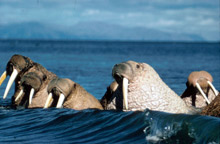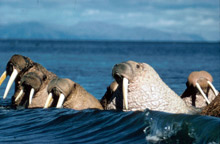 In February 2008 the Center for Biological Diversity petitioned to list the Pacific walrus under the Endangered Species Act because of the increasing loss sea ice habitat.
In February 2008 the Center for Biological Diversity petitioned to list the Pacific walrus under the Endangered Species Act because of the increasing loss sea ice habitat.
There are 3 recognized subspecies: Atlantic Walrus (Odobenus rosmarus rosmarus); Pacific Walrus (O. r. divergens); and Laptev Walrus (O. r. laptevi)
The Bering-Chukchi population was estimated at approximately 230,000 in 1985 and 201,000 in 1990, which is the most recent population estimate
The number of Pacific Walrus in the Laptev Sea region was at one time reported to be 4,000-5,000 individuals. Some recent estimates have put the population above 5,000.
Recent information indicates a population size of perhaps 18,000-20,000 for the Atlantic Walrus
Walruses are one of the largest pinnipeds with Pacific males reaching approximately 3.6 meters in length and weighing 880-1,557 kg. Adult females can reach lengths of 3 meters and a weight of 580-1,039 kg. The Atlantic adults are slightly shorter and lighter.
Used for detecting prey, stiff bristles (mystacial vibrissae) that number from 600 to 700 cover their snouts.
Lifespan is 40 years
“In the summer of 2007, 3,000 to 4,000 mostly young walrus died in stampedes at the extremely-dense, and haulouts on the Chukotka coast, which represents significant mortality.” (Center for Biological Diversity, 2008)
Approximately 7% of the total pacific walrus population spent their summer in the Bristol Bay area in 1985
The types of prey for the Pacific walrus is comprised of more than 60 genera and 10 phyla
~85-95% of their diet are clams
A single walrus may consume more than 6000 clams in a single 16 to 17 hour feeding
The Pacific walrus population reached an all-time low in the 1950s with only 45,000 animals remaining. The cause is attributed to increased human harvesting.
Data: IUCN, Center for Biological Diversity


[…] More here: The Pacific Walrus […]